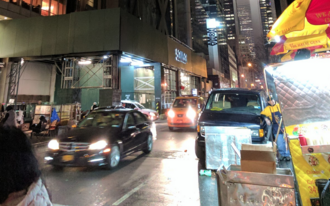Drinking and Driving: The Sobering Reality

Night driving is already dangerous and driving while intoxicated puts you and others on the road at an even greater risk.
Recently, MHS juniors and seniors participated in Every 15 Minutes, a drunk driving simulation that taught students the consequences of driving under the influence of alcohol. The program was emotional and eye-opening for many students, successfully demonstrating the unmitigated horror and catastrophe that results from impaired driving. Given that in 2012 about one in ten high school students said they drink and drive and that 17% of high schoolers involved in fatal car accidents had a BAC of at least 0.08%, combating the issue of DUI is extremely pressing.
From as early as elementary school, in programs such as D.A.R.E., children are taught that drugs and alcohol are dangerous, not only for the user, but also for the people close to them. Throughout middle school, discussions about drug and alcohol abuse become more serious and in high school, teenagers are bombarded by facts and statistics about the mental and physical health consequences of drinking and doing drugs. However, the sheer number of alcohol and drug related accidents in teens evidence that more preventive efforts need to be taken in order to reduce the macabre statistic. Rather than busting teens for underage drinking, maybe schools should focus more on teaching safe driving.
One way schools can effectively counter alcohol related accidents is by being more open about safe drinking habits and decision making. While consuming alcohol under the age of 21 is illegal, it is not possible for educators, parents, and officers to eradicate underage drinking. However, they can control whether or not teens will get in a car afterwards. Students should learn how to recognize when a friend is under the influence of alcohol, even if they claim they are fine. Also, schools should teach students how to be assertive without being confrontational and that it is even okay take away someone’s keys, if necessary. Hands-on experiences, like Every 15 Minutes, are also highly effective because they force students to understand the consequences of their decisions. For example, Ford has developed a “drunk suit” that simulates the feeling of being intoxicated by impairing movement and sight, so that students can experience the reason why drinking and driving is perilous, first-hand.
At the state level, accidents can be prevented by increasing police surveillance of roads at night and implementing sobriety checkpoints in high traffic areas at night. These measures may deter drivers from driving under the influence and can help police officers stop people who may be intoxicated. Another method of preventing DWI is by implementing alcohol ignition interlocks programs to penalize serial drunk drivers. Alcohol ignition interlocks will not allow the driver to turn on the car unless a breathalyzer attached to the vehicle reads under a 0.02% BAC. According to the CDC, intoxicated driving decreases by 70% for drivers that have ignition interlock systems installed.
Though at some point it is up to the individual to act responsibly when on the road. Fatalities can be prevented by simple, yet crucial actions, such as remembering to wear a seatbelt and following the speed limit, especially at night. In addition to not driving drunk, teens should never get in the car with someone who may be intoxicated or allow a friend whose judgement may be impaired to drive; the decision to call an Uber or a taxi can save lives.
One of the most important lessons that programs, such as Every 15 Minutes, teaches is that every action and decision we make not only affects are our own lives, but a whole network of people surrounding us. Therefore, it is imperative that the whole community — teachers, parents, students, and officers — works together to create the safest possible environment for everyone.
https://www.cdc.gov/motorvehiclesafety/teen_drivers/teendrivers_factsheet.html
http://college.usatoday.com/2016/12/26/students-drunk-driving-suit/
https://www.cdc.gov/motorvehiclesafety/impaired_driving/strategies.html
https://www.cdc.gov/motorvehiclesafety/impaired_driving/ignition_interlock_states.html